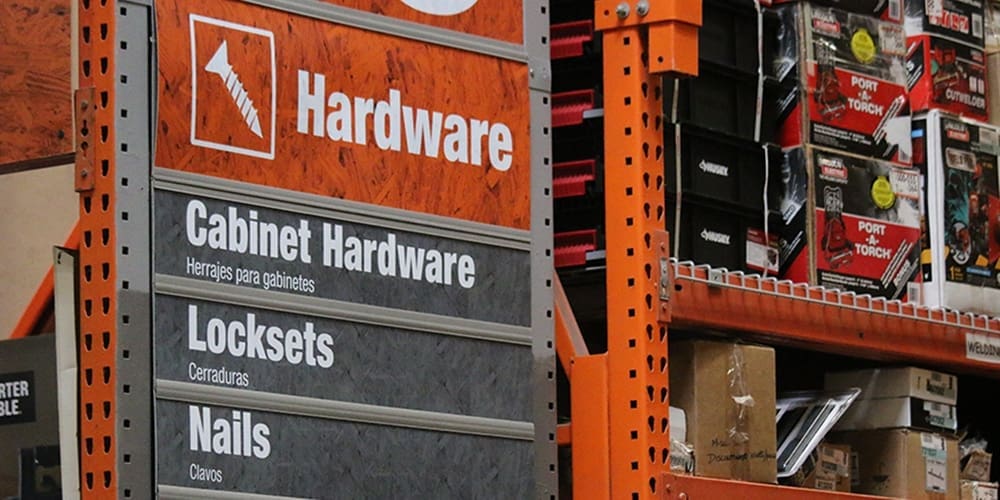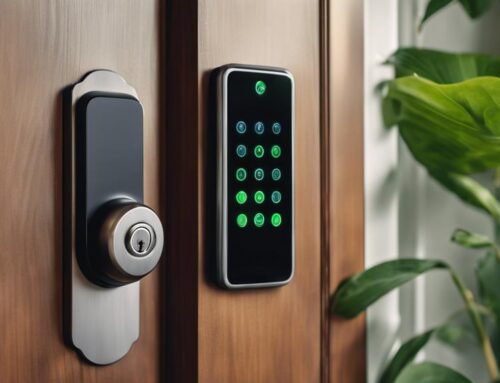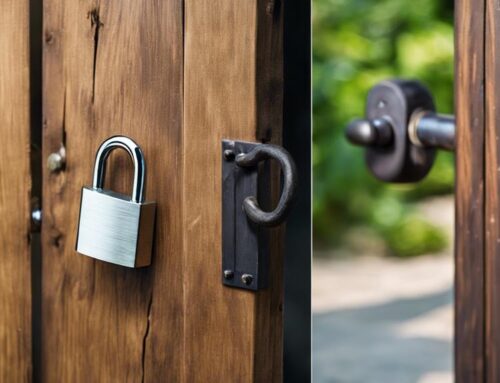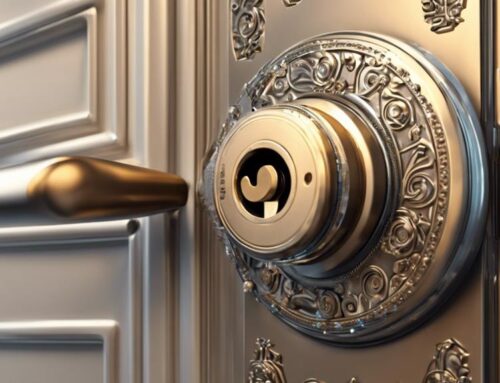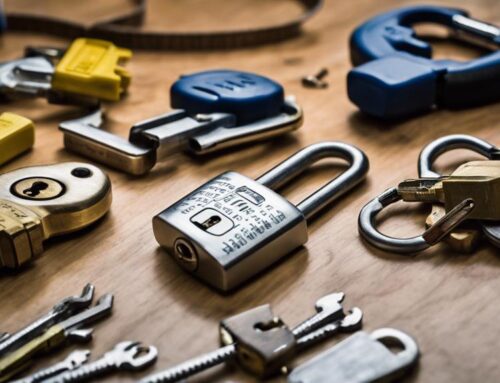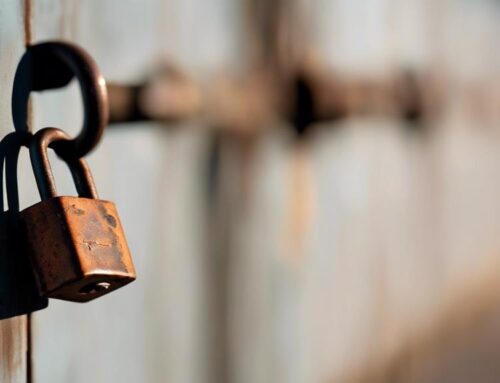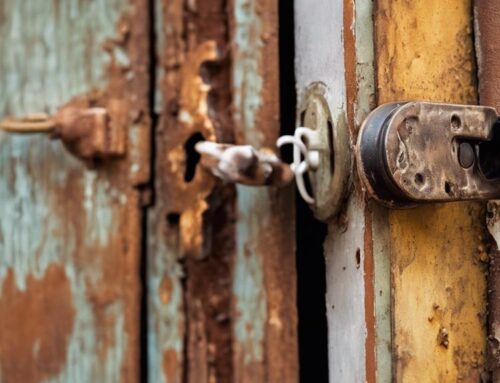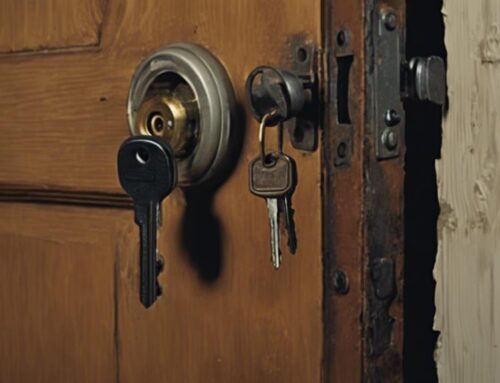When selecting the top lock at Home Depot, start by focusing on lock grades: Grade 1 is best for exterior doors due to its strength and durability. Measure your door‘s backset, cross bore, and thickness for a proper fit. Determine door handing to ensure the lock functions correctly—stand outside to check hinge placement. Explore smart lock options like Wi-Fi, Bluetooth, and keypads for keyless entry. Enhance security with deadbolts and sturdy door materials. Excellent selection hinges on understanding these technical aspects, which you’ll master to find the perfect lock for your home.
Key Takeaways
- Opt for Grade 1 locks for exterior doors to ensure maximum strength and longevity.
- Measure backset, cross bore, and door thickness accurately to guarantee a proper lock fit.
- Select high-security locks with pick-resistant features like mushroom pins or pick shields.
- Choose smart locks for keyless access, considering Wi-Fi, Bluetooth, keypad, or key fob options.
- Use durable materials and additional physical security measures like deadbolts and chain locks to enhance home security.
Lock Grades and Ratings
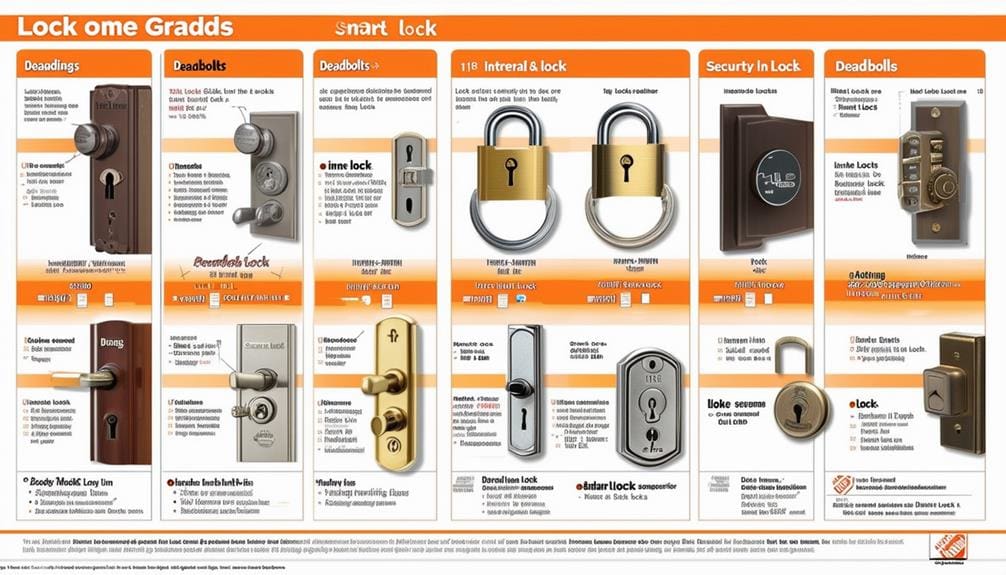
How can you ensure your lock offers the best durability for your home? Start by understanding lock grades and how they impact both durability and security level. Lock grades, established by ANSI (American National Standards Institute), indicate the strength and longevity of locks. Grade 1 locks are the highest standard, providing the ultimate in strength and durability, ideal for exterior doors where security is paramount.
When evaluating locks, don’t just focus on the grade. Prioritize pick resistance and bump-proof features. High-security locks often incorporate mushroom pins or pick shields, making them resistant to picking and bumping—common methods used by intruders. A lock’s grade does not directly correlate with its security level; instead, it reflects the lock’s durability under stress.
Choose locks with robust construction and advanced security features. Deadbolts, for instance, are renowned for their sturdy build and resistance to forced entry, making them a superior choice for front doors. By prioritizing these elements, you can assure that your home’s locks offer both exceptional durability and a high security level, safeguarding your property effectively.
Measuring for the Right Fit
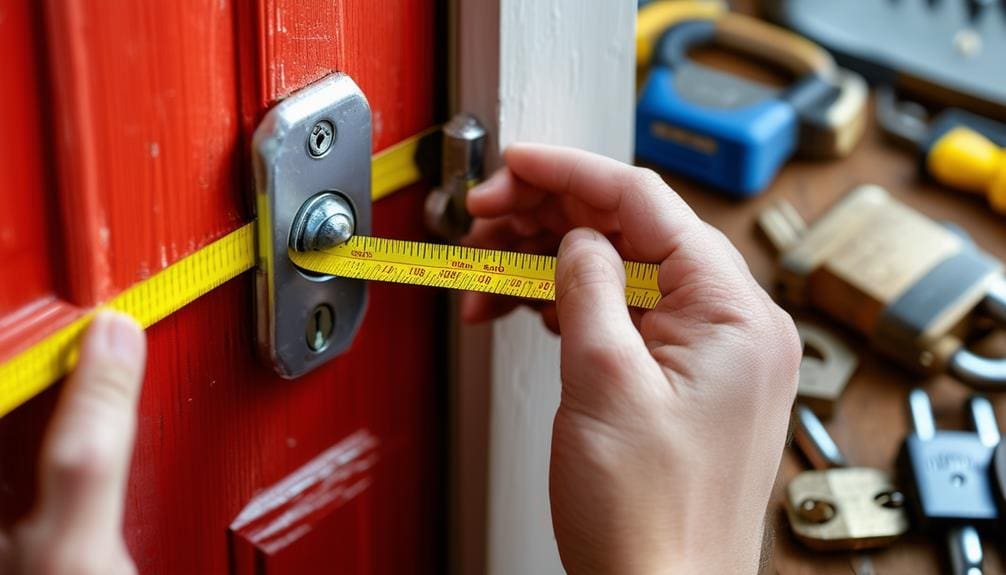
Precise measurements of your door’s backset, cross bore, and thickness are vital to guarantee seamless compatibility and peak performance when selecting a new lock. Start by measuring the backset, the distance from the door edge to the center of the lock hole. Common backset measurements are 2 3/8 inches or 2 3/4 inches. Accurate measurement secures the lock aligns correctly with the latch.
Next, determine the cross bore, the diameter of the hole where the lock mechanism is installed. Standard cross bores are usually 2 1/8 inches in diameter. Verifying this dimension is essential for ensuring the lock fits securely into your door.
Door thickness is another key measurement. Exterior doors typically measure 1 3/4 inches thick, whereas interior doors are generally 1 3/8 inches thick. Accurately measuring your door’s thickness guarantees you select a lock designed for that specific door type.
Understanding Door Handing
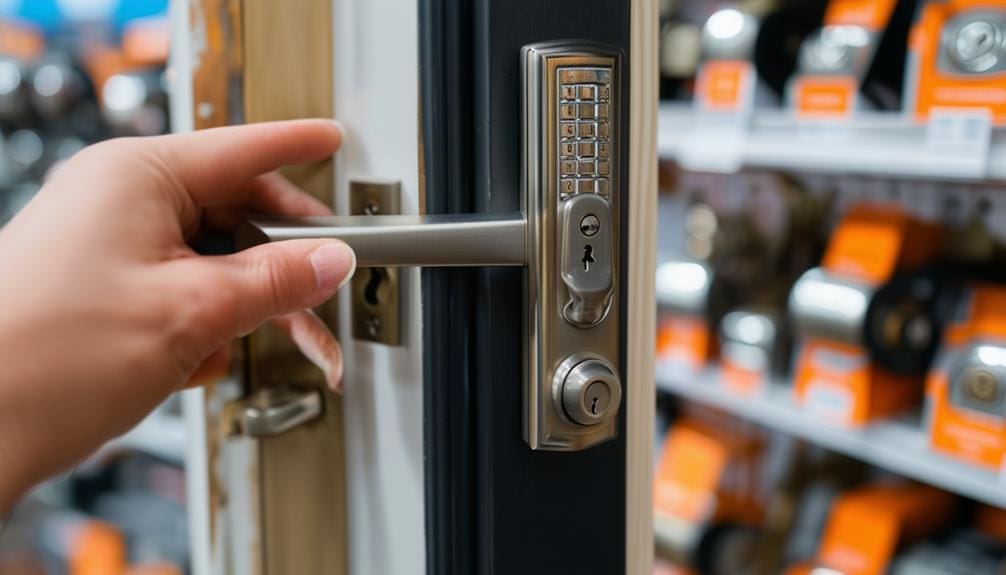
After confirming your measurements are accurate, it’s equally important to understand door handing to select the correct lock for your door’s hinge placement. Handing determines whether a lock is right-handed or left-handed, which is vital for proper lock installation and best functionality.
To determine the handing required, stand outside the door and observe the hinge placement. If the hinges are on the right side, you need a right-handed lock. Conversely, if the hinges are on the left side, a left-handed lock is necessary. This step ensures that the lock will operate smoothly and securely.
For those seeking flexibility, consider reversible or universal handing locks. These versatile options can be adjusted to work with both right-handed and left-handed doors, simplifying the selection process and accommodating future changes in door orientation.
Incorrect handing can lead to installation issues and compromised security, making it crucial to verify this aspect before making a purchase. By understanding and selecting the correct handing for your lock, you guarantee that your door’s lock system will function as intended, providing both convenience and enhanced security for your home.
Smart Lock Options
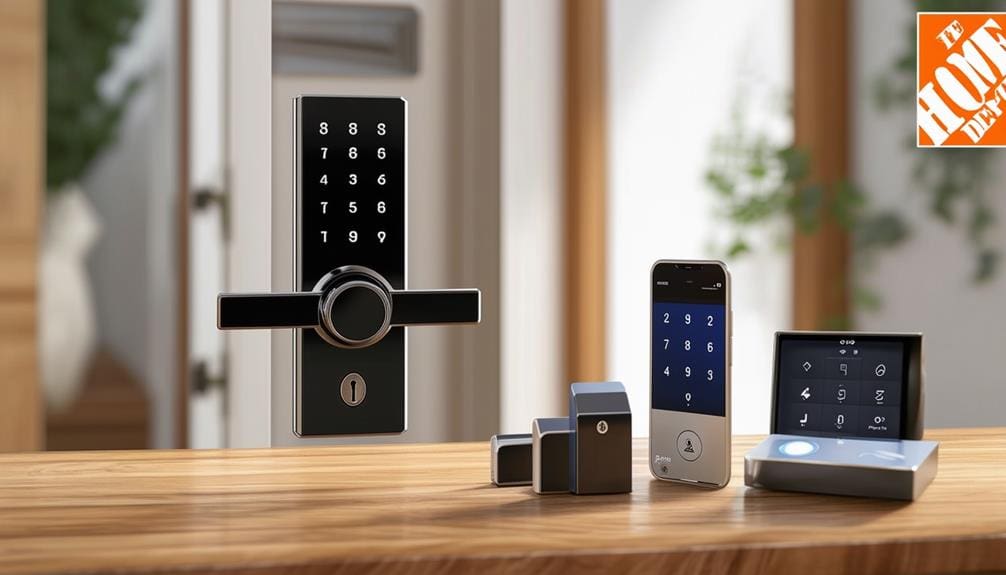
Choosing the appropriate smart lock for your residence involves assessing various choices that offer keyless access through smartphones, keypads, key fobs, and remote access formats for heightened security and convenience. Smart locks are crafted to seamlessly integrate with your intelligent home network, functioning on protocols such as Wi-Fi, Bluetooth, or Z-Wave. Each type offers distinct advantages tailored to diverse requirements.
Wi-Fi smart locks grant remote access, allowing you to manage your locks from any location using your smartphone. These locks link to your home router, enabling real-time monitoring and control.
Bluetooth smart locks provide an additional level of convenience, connecting directly to your smartphone to enable automatic opening when you are nearby. These locks utilize advanced encryption technology to guarantee security and regular software updates.
Keypad smart locks necessitate a code for entry, providing a simple and secure solution without the requirement for physical keys. On the other hand, key fob locks, activate with a button press when the fob is within range, adding an extra layer of convenience.
Below is a summary table detailing the primary features of various smart lock types:
| Smart Lock Type | Keyless Access Method | Connectivity Protocol |
|---|---|---|
| Wi-Fi | Smartphone | Wi-Fi |
| Bluetooth | Smartphone | Bluetooth |
| Keypad | Code | N/A |
| Key Fob | Button Press | N/A |
| Z-Wave | Smartphone | Z-Wave |
Physical Security Measures
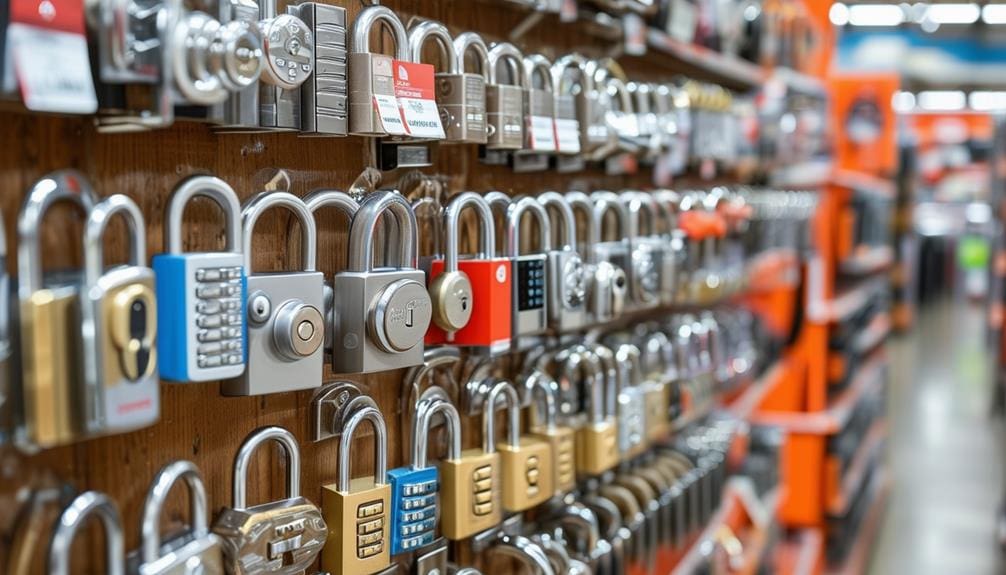
While smart locks offer a technological edge, bolstering your home’s defenses with robust physical security measures remains paramount. Start by securing your entry door with durable materials. Opt for metal, solid wood, or fiberglass for exterior doors to enhance resistance against forced entries. These materials provide a strong first line of defense, reducing the likelihood of break-ins.
Next, focus on reinforcing door locks. Installing deadbolts, particularly double-cylinder locks, on your entry door adds an extra layer of security. These locks require a key on both sides, making it harder for intruders to gain access even if they break a nearby window. Deadbolts are essential for any exterior door, offering superior resilience against forced entry compared to standard locks.
Additionally, consider metal security doors. These doors act as a formidable barrier, further diminishing the chances of unauthorized entry. You can also enhance your security setup with chain locks. Although simple, chain locks provide an additional obstacle for potential intruders, adding another layer of deterrence.
Frequently Asked Questions
How Do I Choose the Best Lock?
To choose the best lock, evaluate lock security, keyless entry options, deadbolt types, and smart locks. Guarantee lock durability and follow installation tips. Measure your door accurately for a proper fit and match the lock style to your home.
What Are the Best Locks to Keep Burglars Out of Your House?
For top security features, choose Grade 1 deadbolts with pick-resistant, bump-proof technology, and mushroom pins. These locks offer excellent durability options and fall within a moderate price range, providing both strength and advanced protection against burglars.
What Kind of Door Lock Should I Get?
You’ll want nothing less than the ultimate fortress for your home. Consider keyless options with smart technology for advanced security. Deadbolt locks offer superior protection over knob locks, ensuring peace of mind and a virtually impenetrable barrier.
How to Know What Door Lock to Buy?
To determine what door lock to buy, evaluate keyless entry options, smart lock technology, and security grade ratings. Measure your door’s dimensions, consider reversible handing, and confirm compatibility with your door’s thickness for best security and convenience.
Conclusion
Choosing the best lock for your home may seem like rocket science, but it’s just door security, right? By understanding lock grades, measuring accurately, considering door handing, exploring smart lock options, and reinforcing physical security measures, you’ll be the unexpected locksmith of your neighborhood. It’s ironic how a simple door lock can turn you into an expert in home security. Now, just don’t forget your keys inside—because that might require actual rocket science.

